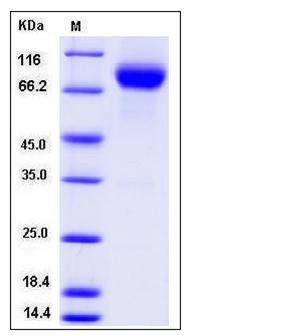Human LSAMP Protein (Fc Tag)
FLJ34254,FLJ35396,FLJ37216,FLJ54658,IGLON3,LAMP
- 100ug (NPP2319) Please inquiry
| Catalog Number | P12136-H02H |
|---|---|
| Organism Species | Human |
| Host | Human Cells |
| Synonyms | FLJ34254,FLJ35396,FLJ37216,FLJ54658,IGLON3,LAMP |
| Molecular Weight | The secreted recombinant human LSAMP/Fc is a disulfide-linked homodimer. Yhe reduced monomer consists of 528 amino acids and has a predicted molecular mass of 59 kDa. As a result of glycosylation, the apparent molecular mass of rhLSAMP/Fc monomer is approximately 80-85 kDa in SDS-PAGE under reducing conditions. |
| predicted N | Val 29 |
| SDS-PAGE |  |
| Purity | > 97 % as determined by SDS-PAGE |
| Protein Construction | A DNA sequence encoding the human LSAMP (Q13449) (Met 1-Asn 315), without the pro peptide, was was fused with the Fc region of human IgG1 at the C-terminus. |
| Bio-activity | 1. Measured by its binding ability in a functional ELISA. 2. Immobilized recombinant human OPCML-His (P10328-H08H) at 10 μg/mL can bind recombinant human LSAMP-Fc with a linear range of 31.25-250 ng/ml. |
| Research Area | Signaling |Signal Transduction |Protein Trafficking |Organelle Proteins |
| Formulation | Lyophilized from sterile PBS, pH 7.4 1. Normally 5 % - 8 % trehalose and mannitol are added as protectants before lyophilization. Specific concentrations are included in the hardcopy of COA. |
| Background | The limbic system-associated membrane protein (LAMP) is a cell surface glycoprotein expressed by cortical and subcortical regions of the mammalian CNS that comprise or receive direct projections from limbic system structures. The 64-68-kDa glycoprotein limbic system-associated membrane protein (LsAMP) is expressed on the surface of somata and proximal dendrites of neurons. These areas perform cognitive and autonomic functions, also learning and memory. The functional analysis indicates that LsAMP acts as a selective adhesion molecule, serving as a guidance cue for specific patterns of connectivity, which underlies the normal development of the limbic system. In animal studies there have been found that rats with increased level of anxiety had 1.6-fold higher expression of LsAMP gene in the periaqueductal gray compared to rats with low level of anxiety, indicating a possible role of LsAMP in the regulation of anxiety. |
| Reference |
